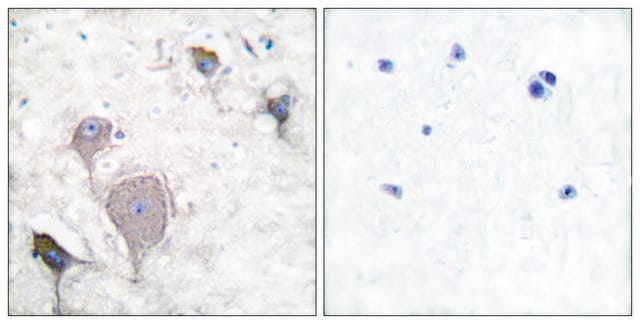MAB1527
Anti-Peripherin Antibody, clone 8G2
culture supernatant, clone 8G2, Chemicon®
Synonim(y):
Anti-NEF4, Anti-PRPH1
About This Item
Polecane produkty
pochodzenie biologiczne
mouse
Poziom jakości
100
300
forma przeciwciała
culture supernatant
rodzaj przeciwciała
primary antibodies
klon
8G2, monoclonal
reaktywność gatunkowa
pig, rat, bovine, human, mouse
producent / nazwa handlowa
Chemicon®
metody
immunocytochemistry: suitable
immunohistochemistry: suitable
western blot: suitable
izotyp
IgG
przydatność
not suitable for immunohistochemistry (Paraffin)
numer dostępu NCBI
numer dostępu UniProt
Warunki transportu
dry ice
docelowa modyfikacja potranslacyjna
unmodified
informacje o genach
human ... PRPH2(5961)
Powiązane kategorie
Opis ogólny
Specyficzność
Immunogen
Zastosowanie
Immunohistochemisty: light PFA fixation is necessary as 8G2 is sensitive to heavy formalin fixation. Antigen recovery is enhanced with 0.1% triton in the block only. 1:25-1:200
Immunoblotting: The antibody is clean and specific for the expected 57kDa band on Western blots.
Optimal working dilutions must be determined by end user.
Neuroscience
Sensory & PNS
Neuronal & Glial Markers
Opis wartości docelowych
Postać fizyczna
Przechowywanie i stabilność
Komentarz do analizy
Rat sensory neurons, rat spinal cord homogenate and peripheral nerve homogenate
Inne uwagi
Informacje prawne
Oświadczenie o zrzeczeniu się odpowiedzialności
Nie możesz znaleźć właściwego produktu?
Wypróbuj nasz Narzędzie selektora produktów.
polecane
Kod klasy składowania
11 - Combustible Solids
Klasa zagrożenia wodnego (WGK)
WGK 3
Temperatura zapłonu (°F)
Not applicable
Temperatura zapłonu (°C)
Not applicable
Certyfikaty analizy (CoA)
Poszukaj Certyfikaty analizy (CoA), wpisując numer partii/serii produktów. Numery serii i partii można znaleźć na etykiecie produktu po słowach „seria” lub „partia”.
Masz już ten produkt?
Dokumenty związane z niedawno zakupionymi produktami zostały zamieszczone w Bibliotece dokumentów.
Nasz zespół naukowców ma doświadczenie we wszystkich obszarach badań, w tym w naukach przyrodniczych, materiałoznawstwie, syntezie chemicznej, chromatografii, analityce i wielu innych dziedzinach.
Skontaktuj się z zespołem ds. pomocy technicznej





